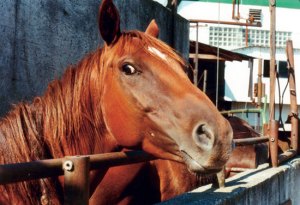Information supplied by the Equine Welfare Alliance and Animal Law Coalition
Agency’s Credibility Now in Jeopardy

Slaughter Bound ~ photo courtesy of ALC
Chicago (EWA) – The long awaited Government Accountability Office (GAO) report on horse welfare fell far short of the respectable reporting we have come to expect from the GAO, even raising questions as to the agency’s credibility.
The Equine Welfare Alliance (EWA) and Animal Law Coalition (ALC) have issued an exhaustive analysis and executive summary, demonstrating the embarrassing and shocking lack of evidence for GAO’s findings.The analysis concludes that the GAO report is “disturbing” as it is filled with speculation, anecdotes, hearsay and unsupported opinions. The GAO sources appear to be largely known slaughter proponents.
“The GAO’s pro-slaughter bias is clearly evident in the report’s defamatory accusation that the Cavel fire in 2002 was started by so-called anti-slaughter arsonists,” states co-author and EWA vice president,
Vicki Tobin. The cause of the fire was never determined and it was Cavel’s owners who benefited from the fire, claiming $5M when the damages were estimated at $2M.
The EWA/ALC analysis details how, instead of doing the hard work of gathering actual data, the GAO relied on chitchats with a handful of state veterinarians with a few livestock board and other state officials and on information provided by pro-slaughter organizations.“The GAO’s economic models fail to credibly take into account basic principles of supply and demand, the extremely limited effect of slaughter on the horse industry and the devastating effects of one of the worst economic downturns since the Great Depression”, said ALC’s Laura Allen. “Instead, the GAO report blamed the closing of 3 U.S. horse slaughter plants in 2007 for a decline in live horse prices, loss of horse markets, and a rise in horses in need.”
Carolyn Betts, Ph.D. Economics explains, “There is, by definition, no correlation between something that stays roughly constant over time – the number of horses slaughtered – and something that the GAO claims has gone up significantly over the same time period – the number of horses abandoned and neglected. In the absence of an observable correlation, it is nothing short of “heroic” for the GAO to assume a causal relation from a proximate constant to a variable that it argues has increased.”
A FOIA request for the data and methods the GAO used in developing its economic models was denied by the Congressional Committee that requested the GAO report. The EWA/ALC analysis concludes that this is nothing short of a Congressional cover-up for the GAO’s unsubstantiated claims.
A study by John Holland, co-founder and president of EWA, which was provided to GAO, found that cases of horse abuse and neglect in Illinois rose and fell with the unemployment rate. The same study found absolutely no mathematical correlation between these cases and the rate of slaughter.
The EWA contends that slaughter actually contributes to the problem of too many horses by enabling over-breeding and driving down prices. GAO’s economic model, done correctly, would have shown that prohibiting export of horses for slaughter would be the one thing that would really improve horse welfare over the long term.
The analysis also points out that the GAO report completely glossed over critical food safety issues raised by the slaughter of American horses for human consumption. The GAO was indifferent to the export of U.S. horses for slaughter for human consumption despite the fact that these horses contain drugs, such as phenylbutazone, which the FDA bans for use in animals used for food. Vicki Tobin explains, “U.S. horses are not raised or regulated as food animals. Given the importance of food safety, horse slaughter for human consumption should not even be a discussion point in a government report, let alone a recommendation.”
Probably one of the more ridiculous recommendations by the GAO is that USDA/APHIS will do better in enforcing humane transport regulations if there is slaughter available in the U.S. But historically, USDA/APHIS has always done an abysmal job of enforcing these regulations. Long before the 2007 closings, horses were exported for slaughter in large numbers and suffered on long, arduous trips over the borders and within the U.S.
In fact, the GAO’s discussion of APHIS’ shocking ineptitude and indifference to horses and the horrific mistreatment they endure throughout the slaughter pipeline is reason enough for Congress to ban horse slaughter and to do it now.
The GAO report and the EWA/ALC report will be discussed at the upcoming International Equine Conference, Sept. 26-28. Visit http://www.equinewelfarealliance.org/Int_l_Equine_Conference.html for additional information and to register.
The Equine Welfare Alliance is a dues-free 501(c)(4) umbrella organization representing 189 organizations and hundreds of individual members worldwide. The organization focuses its efforts on the welfare of all equines and the preservation of wild equids.www.equinewelfarealliance.org
The Animal Law Coalition is a coalition of pet owners and rescuers, advocates, attorneys, law students, veterinarians, shelter workers, decision makers, and other citizens, that advocates for the rights of animals to live and live free of cruelty and neglect.www.animallawcoalition.com
Click (HERE) for GAO Study
Click (HERE) for EWA and ALC Analysis
Click (HERE) for EWA and ALC Executive Summary
Related articles
- GAO Releases Alleged Leaked Horse Slaughter Report (rtfitch.wordpress.com)
- Animal Law Coalition Responds to GAO Horse Slaughter Report (rtfitch.wordpress.com)
- “Unwanted Horse” Producer Pfizer Sponsors Teleconference to Promote Compromised GAO Report (rtfitch.wordpress.com)
- The Way Forward on Horse Welfare (rtfitch.wordpress.com)
- The True Unintended Consequences of Horse Slaughter (rtfitch.wordpress.com)
- International Equine Conference on Equine Welfare and Food Safety (legalaction4animalrights.net)
- Mexico Equine Advocates Appeal Globally for Help (rtfitch.wordpress.com)
- Equine Advocacy Blog Hits 1 Million Viewer Milestone (rtfitch.wordpress.com)
- Letter to Horseback Online: EWA Official Calls Wallis Facebook Information Bogus (rtfitch.wordpress.com)









No comments:
Post a Comment